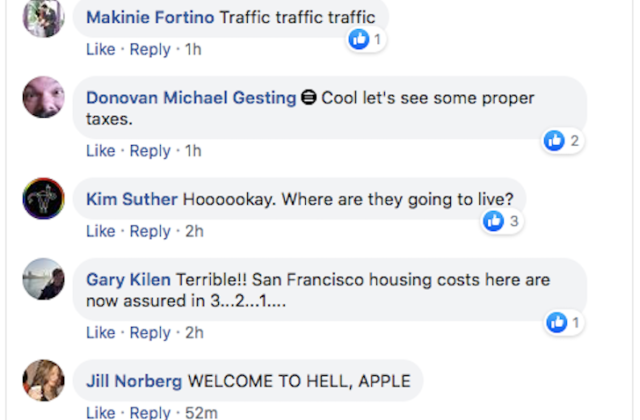Seattle Times: What’s Next With Socialism in Seattle?
It’s worth reflecting that not that long ago, President Obama had to deny charges that he was a socialist. In fact, the term, along with communist, was considered an epithet, and insult. It was a way of saying, “You’re way too extreme to be taken seriously.” This norm about socialism has disappeared, and now, in spite of the Cold War ending just 30 years ago, socialism is worn as a kind of badge of honor. People like to say, “I’m a socialist!” The Seattle Times ran a story wondering about what will happen with socialism in this years election. The real question is, “How did we get here?” and “How do we change this?”
Here’s what the Times rightly points to as part of the appeal of the socialist’s standard bearer in Seattle, City Councilmember Kshama Sawant:
Talking to voters on Capitol Hill, Angelou-Lysaker led with a question: “Hey, do you support rent control?” Then she explained how Sawant would like to limit rent hikes to the local rate of inflation.
Seattle can’t implement that policy without the state Legislature repealing its ban on rent control, but Angelou-Lysaker says the issue speaks to voters. Housing costs have displaced people of color, particularly.
The first answer to the question of how we wound up even taking such a destructive worldview seriously goes right back to basic politics: say what people want to hear! When Sawant ran for office originally, for state legislature, she almost nothing but “$15 Now!” That’s it. Nothing else. Why $15? Who knows? It was a figure that was higher than the minimum wage at the time. She ended up winning because she never wavered from that simple message, “Vote for me, and I’ll raise your pay or other people’s pay you think deserve it.” How much? $15 an hour. When? Now!
Contrast that with the mealy mouthed and counter productive sloppiness of an outfit like the Greater Seattle Chamber of Commerce which supported current Mayor Jenny Durkan with a “Make them (developers) pay their fair share” television advertisement in 2017. Here’s what is supposed to be the leading champion of markets and opportunity in the region supporting a tax on the construction of all new housing. Why? Because it would make them look more like Sawant; that’s why I call the Chamber the Greater Seattle Chamber of Communists. No organization has done more to normalize things like price controls and micromanagement of workers schedules like that Chamber.
Add to that the fact that, as the story points out, Sawant’s rhetoric “pushed City Hall conversations left on tenant rights,” a place it never needed to go. Sawant hasn’t really passed an significant legislation. She blusters and blares into a bullhorn, but it is the Chamber backed members like former Councilmember Tim Burgess and former Mayor Ed Murray who made her policies law. Burgess spent time criticizing Sawant privately but then lead the effort to pass a resolution that put the Council in support of rent control.
Will this trend continue? For what it’s worth, my intuition tells me that no matter what the Chamber does with its money, the Council that gets elected this fall will have a stronger connection with angry neighbors fed up with tents and garbage and needles in the park. Does that mean that the days of socialism are over? Probably not. Socialism’s sentiment is all about using someone else’s money to solve other people’s problems. Angry neighbors and their new council are just as likely to support rent control and other anti-business legislation as the socialists perhaps for less ideological reasons. My guess is that voters are over the novelty of socialism and are now embracing the idea of law and order, something that won’t speed up building permits or take away regulations that slow new housing.
Sadly, the idea that we can stop rising prices by just demanding them to stop going up is likely to stay popular. To counter that, we’ll need good and consistent data to show that, yes, in fact, when there is more of something it’s price goes down. Second, we’ll need good ideas like more direct cash subsidies to help offset inflationary pressure for people with the fewest dollars in the economy, and finally, we need to give people something they believe in, more opportunity. Until we change the narrative this way, we are likely to see socialism thrive.
Thousands of New Jobs In Seattle: “Welcome to Hell Apple!”
There was a telling exchange (if you can call it that) on Facebook in the last week or so when Seattle Mayor Jenny Durkan proudly announced jobs coming to Seattle.
The Mayor’s Facebook posts are generally either tone deaf or read as if they were written by an algorithm. “We have the best talent anywhere!” Somehow she tries to be a cheerleader for the city as if she was rooting for the Seahawks. I suppose that’s what Mayors do. But then there’s the “Yet..”
Yet we know that as Seattle continues to grow, we must act urgently to address the pressures that follow – from tackling affordability to new affordable housing to increasing transit.
“The pressures that follow.” Durkan, or more accurately the person or program that writes her social media, reflexively adopts the stance that jobs cause problems with affordability. You see, when jobs come prices go up. For people like Durkan, most people really, that means there is a “yet” that happens. Prices go up. There are problems with transit and traffic. Yet.
And this is why Durkan, out of her element in the office, will likely end up walking away from the job at the end of her term. The statement she makes simply has to cancel out the positive statement with a “yet.” But worse, it simply isn’t true. There is no downsides to new jobs unless, and that’s the word she should be using, unless. More new jobs are a really great thing for everyone unless a city has no leadership or coherent strategy to create more housing, then that city will see prices “skyrocket,” and have people who earn less money end up paying more and more of their income for housing.
Then there is another word: until. I use both of these words now. Unless and until. Unless and until. Unless and until we have leadership, job growth will cause problems because supply won’t keep up with demand. That means suffering for people who earn less money.
And oddly, most of the commenters just bash the Mayor, hundreds of them, blaming her for the jobs and the problems and the problems with jobs. Unless and until we have a Mayor that can cheer on job growth and support policies that relieve regulatory burdens and step back from schemes like Mandatory Housing Affordability, we will continue to have problems with housing prices.
Forbes: Impact Fees? Local Government Should Provide Infrastructure for Free
I’ve been writing a lot more at Forbes lately. This month has fit that pattern. Yesterday I put up a post there about infrastructure that was based on my thoughts after using bike share on bike lanes here in Seattle. What we’re doing with transportation infrastructure, as a matter of policy, is paying for it with tax dollars. The idea is that if we make it super easy to use other modes besides the car, people won’t drive as much. Part of that policy is freeing up “free” right of way for those alternative modes. As they say, “There is no such thing as a free lunch.” So the wider tax paying community is paying for those bike lanes and sidewalks. What about housing? We make buyers and renters pay for infrastructure.
Over the years, many cities have decided to impose impact fees on housing, something that all by itself indicates the way people in these cities see new housing – as an bad thing that needs to be mitigated. Often impact fees are used to pay for “free” use of things like sidewalks, roads, and other infrastructure. What if we didn’t see housing as an impact?
My point in the post is that if we treated housing like riding bikes in Seattle, we wouldn’t be considering impact fees, we’d be taking away the existing requirement to pay for sidewalks, drainage, sewer capacity, and all the other things that new housing absorbs. Growth should pay for growth? How about we all pay for it and lower housing prices? That would be innovation and it would lower prices.
Read the whole post at Forbes.

Showbox: A Case Study in Confusion and Misdirection on Growth
A recent story about Seattle’s latest incoherent response to growth and housing policy starts out, “Emotions have been running high in Seattle over the Showbox..” True. Emotions and not much else. The story in Curbed reports on the failure in court by the City of Seattle to defend it’s efforts to zone the location of the Showbox into oblivion, making it part of the Pike Place Market Historic District and thus off limits to serious redevelopment. For what it is worth, here’s what is really happening here and why it shows how Seattle’s government and community are behaving like Mr. Magoo when it comes to growth; the difference is that Mr. Magoo was funny to watch, while Seattle’s bumbling is tragic.
The Showbox is an old brick building. There is simply nothing remarkable about it’s structure or construction. I haven’t read anyone enraptured by the architecture, design, or materials. What we have seen is a lot about the use of the building and what has gone on there over the last 80 years. I’m a person who will travel miles out of my way to drive on a road debated in the 19th century and finally built in the 20th. Yes, a road. So I don’t need to be lectured on the importance of “what happened there” as the basis for preservation.
For me, the question is about the nexus of that particular place and what happened and then, most importantly, can the location be practically maintained for that purpose. In this case, sure, if someone wanted to buy the Showbox as a venue and keep it going, I’d have no problem letting that owner use it for that purpose rather than housing. It would be her private property to use as she wished within the limits of the law.
But here’s another fact left out of the reporting of this story consistently: the old brick building is an unreenforced masonry building, or more technically a URM. That means the building is on a list of buildings that are hazardous in an earthquake, an event that is inevitable according to scientists. So if our nostalgic owner bought the building, determined to carry on the tradition as a music venue, she’d have to fix the building. That would cost a lot of money. How much? Hard to say, but most owners of these buildings tell me that to meet safety requirements does two things, costs a lot of cash and takes the building out of service.
I’m a philosophy major with a graduate degree in religious studies. But what I do know about business is that income for a business must meet or exceed costs. The problem with this business, this use, is that the receipts at the door are not going to match the costs of the upgrade. They never will. Adding more seats or capacity to the venue and even boosting ticket prices won’t work because once capacity is increased the new requirements for seismic safety would kick in. Our new owner, determined to operate the venue as a theater would have a choice: shut the venue down and cut loses or spend millions on the improvements and operate it at a loss. If she’s a billionaire, maybe that makes sense.
The economics and seismology just won’t work here. Ever. Why do you think the Showbox business opened a new venue in the Duwamish. My guess is that anyone with a knowledge of operating a venue like this with a look at the books would conclude that the costs of running the venue — even if it was a perfectly safe building — are higher than the economic potential. That is, the location needs work no matter what. Other theater venues like the 5th Avenue and the Paramount have undergone similar rehabs to keep up with the times, but they did so with significant subsidies and as non-profits in some cases.
So forget about Amazon and growth and the gauzy “vanishing Seattle” sentiment, this venue won’t work, period. If the advocates are successful, it is quite likely the business part of the site will leave. Nobody will take the lease and we’ll have a dead building like the Lusty Lady was for many, many years. Unless someone is willing to operate at the venue with it’s constraints and lose money, or make huge improvements to meet URM requirements (and probably lose money), the building will be, as I’ve pointed out before, a padlocked pile of bricks with a storied past.
The best option for the site is to create a memorial for it, knock it down, and build as much housing there as possible.
But we can’t even quite get that right. One Councilmember came close, Abel Pacheco.
While Pacheco said he “appreciate[s] the nostalgia” surrounding the Showbox, he believes expanding the historic district is the wrong tool for preservation.
Correct about the sentiment and the policy.
But wrong on the reasons why.
He said there are “major tradeoffs” to preserving the Showbox, including losing out on the opportunity to have the 442 apartment units Onni planned for the site, in addition to “up to $5 million in affordable housing payments” through the MHA program, which exchanges additional building size for either on-site affordable housing or payments toward affordable housing. (The historic district is exempted from MHA rezones.)
No, the $5 million in fees from the extortive Mandatory Housing Affordability scheme don’t rationalize the demolition of the Showbox. That’s absurd economics and not worth the “trade off.” Why? Because $5 million dollars will buy, are you sitting down, about 14 housing units maybe 5 years from now. Maybe. That figure is based on an average construction cost of about $350,000 per unit. Will that price go up or down by the time the money is collected, processed by the office of housing, and then inefficiently dispersed to some non-profit? Who knows. I wish people would stop using their purely political embrace of MHA as a rationale. It’s as silly as nostalgia being used to rationalize keeping a pile of bricks. Meanwhile, hundreds of dangerous buildings wait for an earthquake to happen while the City argues with itself over this one building.
On it goes. Yet another episode of Seattle Magoo Takes On Growth and Preservation. Oh well. Sad! While you’re waiting for the next episode of the Showbox drama you can watch an episode of the original here. Enjoy!
Public Disclosure: “More Dangerous” Ideas Create Concern Among LIHTC Lawyers
As I have mentioned before, one has to brace oneself when doing public disclosure requests; to borrow from Forrest Gump, public disclosure requests are like a box of chocolates, you just never know what you might find. Here’s an example from another Forrest, Forrest Midler an attorney at Nixon Peabody a firm that does a lot of business with Low Income Housing Tax Credits (LIHTC):

At Forbes today I have a post that goes into more detail about an exchange that was picked up because of my recent disclosure request for documents from the Washington State Housing Finance Commission (WSHFC). When I wrote at Forbes after the last presidential election about doing something to change the LIHTC program it sparked a lot of agitation among the powerful class of people that do work in the LIHTC field, mostly attorneys. Faith Pettis at Pacifica Law Group, the attorney for the WSHFC and a co-chair of now disgraced former Mayor Ed Murray’s Housing Affordability and Livability Agenda (HALA) Committee was sharing traffic from a list serve used by LIHTC attorneys.
I suppose the comments aren’t that shocking, but what was interesting is that the lawyers don’t like prevailing wages — except when they do. There’s another project I am looking into in which a Pacifica Law Group attorney was demanding prevailing wage for a private sector project. Why? We’ll see what I find in the documents. It’s probably because Pacifica would rather have one of its non-profit clients do the work and generate fees for them than a private sector partner. More on that later.
But what Forrest Midler points out and another attorney calls “dangerous” is that questioning the LIHTC program which provides lots of capital for inefficient non-profits, is a threat to the people who make a lot of money from “affordable” housing. I’ve been very critical of the non-profits for doing absolutely nothing to reduce costs for housing across the economy; instead they just want more and more money. But where does that money go? To for profit attorneys, consultants, and contractors. Is that bad? Not really. Those companies are earning money from services rendered. But why are they being used in the first place? Why are we building really expensive units instead of just giving families money for rent?
Because lots of interests, for profit companies, make money from producing that expensive housing. I point out at Forbes that is is weird, bizarre even, that socialists and other activists are so anxious to tax corporations simply to take that money and hand it over to a system that produces so much wealth for other corporate interests. It makes no sense. But in the crazy mixed up world of housing, where the housing cost crisis is self-imposed by regulation and the solution is to add costs that drive up prices for consumers there is perverse logic to all this; money gets made from fretting over skyrocketing prices. Will it ever end? I’m not sure. But as long as wealthy interests and law firms stand in the way of getting help to families in need, the “crisis” is unlikely to abate.
Here’s the full document:





